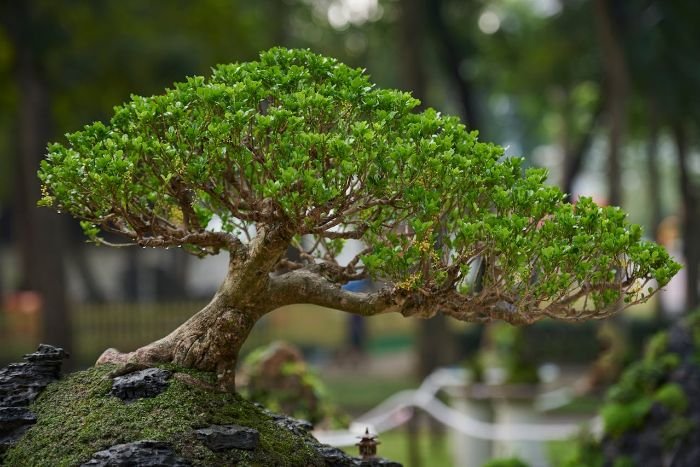Welcome to the world of bonsai, where art meets nature. Bonsai comes from “bon” meaning tray and “sai” meaning tree. It’s the art of growing tiny trees in pots. This art has captured hearts around the globe, thanks to its roots in Japanese culture.
This guide will take you through bonsai’s history and philosophy. We’ll look at different bonsai types and care methods. It’s perfect for both new and experienced bonsai lovers. You’ll learn everything needed to care for these tiny trees.
Key Takeaways:
- Discover the history and philosophy behind the art of bonsai.
- Explore the different bonsai species and learn how to choose the right tree.
- Master basic and advanced bonsai techniques, including pruning, shaping, and grafting.
- Gain insights into essential bonsai care practices, such as watering, fertilization, and repotting.
- Learn how to overcome common bonsai problems and enhance the aesthetics of your display.
Table of Contents
Introduction
Bonsai is an ancient art from China and Japan. It has won the hearts of people worldwide with its beauty and deep meaning. We will look into its history and philosophy, and give an overview of the art.
History and Philosophy of Bonsai
Bonsai’s history goes back thousands of years to early Chinese culture. It was influenced by penjing, the art of growing miniature trees. By the Tang Dynasty (618-907 AD), bonsai started to grow, with scholars and artists adding trees to their gardens.
In Japan, bonsai really took off and became what we know today. Japanese monks and nobles made it popular as a way to meditate and show love for nature. It became a symbol of living in harmony with nature, following the Japanese idea of wabi-sabi, which values imperfection and change.
The philosophy of bonsai is all about balance in nature, like earth, wind, water, and fire. By shaping and caring for a bonsai tree, one can feel peace and balance. Artists aim to make a small version of nature, capturing the spirit of a big tree in a small space.
Overview of Bonsai Art
Bonsai art comes in many styles, each with its own look. Styles range from formal upright to cascade and literati. The pot, branch arrangement, and foliage all add to the bonsai’s beauty.
Creating bonsai trees needs skill, patience, and creativity. Artists use tools and techniques like pruning and wiring to shape the tree. They also make sure the tree is healthy by giving it the right food, water, and new homes when needed.
Throughout history, bonsai has amazed people with its beauty, making them think and admire. It’s a living art that keeps changing, with artists trying new things. Bonsai trees, whether in homes, gardens, or shows, let us see the beauty and strength of nature.
Choosing the Right Bonsai Tree
Finding the right bonsai tree is key for bonsai lovers. You need to think about the tree’s species, traits, and care needs. We’ll look at popular bonsai types and give tips for picking the right one for beginners.
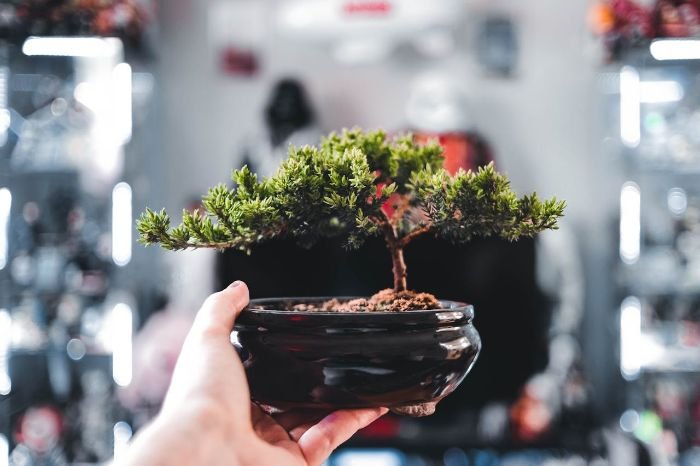
Popular Bonsai Species
Many bonsai species are loved for their beauty and easy care. The Ficus and Juniper bonsai trees are two top picks.
Ficus bonsai trees are versatile and strong. They grow well indoors or outside and have pretty aerial roots and shiny leaves. This makes them a favorite among bonsai fans.
Juniper bonsai trees are known for their beauty and toughness. They fit well in many climates, making them great for newbies. Junipers have unique needles and twisted trunks, adding beauty to any bonsai setup.
Selecting a Suitable Tree for Beginners
For beginners, picking a bonsai tree that’s easy to look after is key. Think about these things when choosing:
- Hardiness – Pick a species that likes your local climate. This helps the tree survive your area’s weather.
- Growth habits – Some trees grow fast and need more care. Choose one that fits your time and effort.
- Ease of care – Some species are more forgiving of mistakes. Look for trees that can easily recover from common mistakes.
Keep these points in mind to find a bonsai tree that’s right for you. This way, you’ll enjoy your bonsai journey more.
Next, we’ll cover basic bonsai techniques. You’ll learn how to prune, shape, and care for your bonsai tree.
Basic Bonsai Techniques
In the art of bonsai, learning basic techniques is key. These include pruning, wiring, and repotting. They help bonsai lovers make beautiful trees that look like nature’s own.
Pruning and Shaping
Pruning is a key skill in bonsai. It means cutting branches and leaves to shape the tree. This keeps the bonsai healthy and looking good.
Shaping lets bonsai lovers control branch growth. By pruning and wiring, they make branches curve and look special. This makes the bonsai look beautiful.
Wiring for Structure
Wiring helps bonsai trees grow in the right shape. It uses wire to bend branches. This makes the tree look nice and balanced.
Wiring is important for the tree’s shape. It makes the bonsai look good and peaceful.
Repotting and Root Trimming
Repotting is key for bonsai trees. It means taking the tree out of its pot, trimming roots, and putting it in new soil. This keeps the tree healthy and stops problems.
Trimming roots is part of repotting. It keeps the roots right-sized for the tree. This helps the tree grow well and stay balanced.
Learning these bonsai techniques helps make beautiful trees. They show the calm of nature in a small way.
Advanced Bonsai Techniques
In the world of bonsai, advanced techniques take the art to new heights. These techniques need skill, patience, and a deep understanding of the bonsai tree’s growth. We will look at three advanced bonsai techniques: grafting, air layering, and defoliation.
Grafting
Grafting combines different plant species to create unique bonsai trees. It joins a cutting or scion from one tree to another’s rootstock. This lets bonsai artists blend the best traits of both trees, making a beautiful bonsai.
Grafting adds fine branches, changes growth direction, or introduces new foliage. It needs precision and skill for a successful join.
Air Layering
Air layering creates new roots on a bonsai tree. It removes bark to encourage new roots. This method helps bonsai artists grow new trees from existing ones, without seeds.
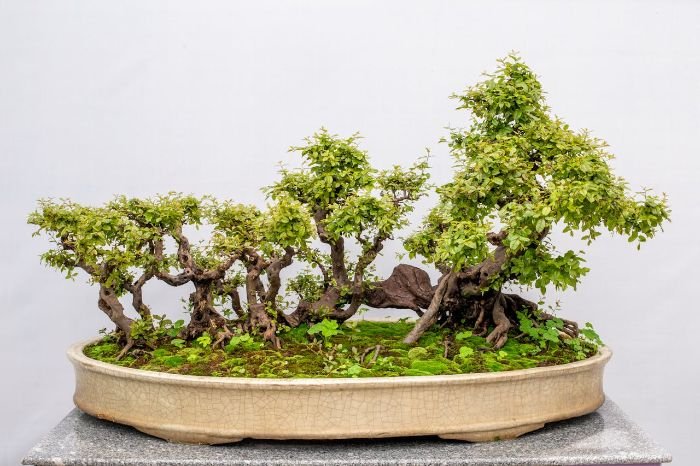
It’s great for species hard to propagate other ways. It ensures new trees with established traits and a better survival chance.
Defoliation
Defoliation makes bonsai trees look better. It removes some or all leaves. This technique boosts ramification (branching) and refines the bonsai’s structure.
Defoliation is done with care and timing. Removing leaves makes the tree focus on new buds and smaller leaves. This leads to a more compact and refined look.
These advanced bonsai techniques – grafting, air layering, and defoliation – let experienced artists shape and refine their work. By learning these techniques, bonsai lovers can create unique and stunning specimens.
Bonsai Care Essentials
Looking after your bonsai trees is key to their health and beauty. We’ll cover the main parts of bonsai care. This includes watering, feeding, soil, and the right light and temperature.
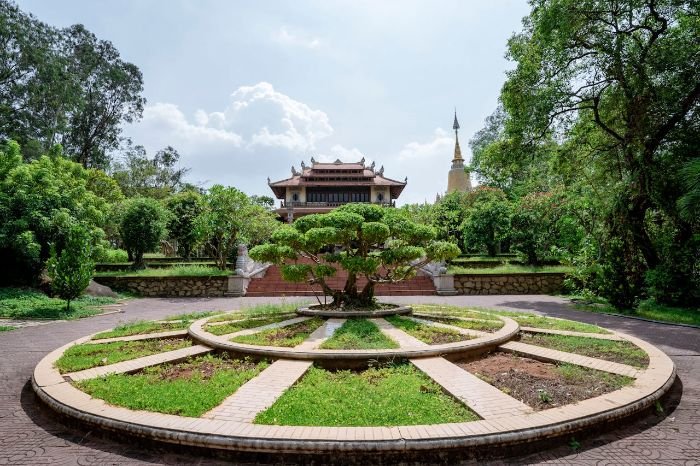
Watering Requirements
Watering your bonsai right is crucial. You need to find a balance to avoid drying out or drowning the tree. The amount of water your bonsai needs changes with the tree type, pot size, and where you live.
Water until water drains from the pot’s bottom. Check the soil’s moisture often and adjust how often you water.
Fertilization Guidelines
Fertilizing your bonsai keeps it healthy and strong. Use a special bonsai fertilizer when it’s growing. How often and what type of fertilizer you use depends on the tree and its stage of life.
Follow the fertilizer instructions closely. Regular feeding gives your bonsai the nutrients it needs for great growth and color.
Soil and Potting Mixes
The soil you choose is very important for your bonsai. It should drain well, breathe, and hold moisture. Popular choices include Akadama, pumice, and lava rock.
Pick the right soil mix for your tree type. Re-potting your bonsai now and then helps prevent root problems and ensures it gets nutrients well.
Light and Temperature Needs
Light and temperature are key for your bonsai’s growth. Most bonsai love bright, indirect light. But, some like full sun and others prefer shade.
Learn what your bonsai likes for light and temperature. Keeping temperatures steady helps your bonsai grow strong and healthy.
By taking care of these essentials – watering, feeding, soil, and light and temperature – you’ll keep your bonsai thriving and beautiful.
Seasonal Care for Bonsai
Bonsai trees need different care with the seasons. Changing your care to match each season helps keep your bonsai tree healthy. We’ll look at what care is needed in spring, summer, fall, and winter.
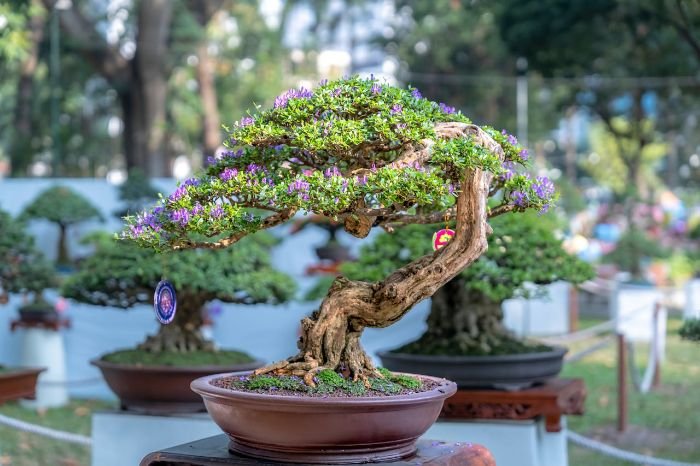
Spring and Summer Care
When it gets warmer and days get longer, bonsai trees grow a lot. It’s key to care for them right to help them grow and stay healthy.
- Pruning – In spring and summer, trimming is key. It keeps your bonsai tree the right size and shape. Cutting off too many branches helps air move better and lets sunlight in.
- Fertilizing – Bonsai trees need food when they’re growing. Use a slow-release fertilizer as the package says. This gives them the nutrients they need for healthy leaves and roots.
- Pest Control – Spring and summer are when pests like to bother bonsai trees. Check your tree often for pests. If you find any, use safe pest control methods or get help from a pro.
Fall and Winter Care
When it gets colder and days are shorter, bonsai trees sleep. You need to change how you care for them during this time.
- Protection from Frost – Keep your bonsai tree safe from the cold. Put it in a warm place or cover it with a frost cloth to protect its leaves and branches.
- Winter Watering – You don’t water bonsai trees as much in winter, but you can’t let the roots dry out. Water it a little, letting the soil get dry before you water again.
- Dormancy Considerations – Your bonsai tree might not grow much or lose leaves in winter. This is normal. Don’t do a lot of pruning or shaping then to let the tree save energy.
By following these tips, you can make sure your bonsai tree stays healthy all year.
Common Bonsai Problems and Solutions
Bonsai trees face many problems, just like any living plants. We’ll talk about pests and diseases, and how to fix them. We’ll also cover growth issues like stunted growth and root rot, and how to prevent them.
Pests and Diseases
Bonsai trees get pests and diseases that slow their growth and health. Pests like aphids and spider mites can damage leaves and spread diseases. Check your bonsai often and act fast if you see pests.
To fight pests, try neem oil or insecticidal soaps. These are safe for your tree and the planet. Keeping your bonsai clean, watering it right, and pruning helps prevent pests too.
Bonsai trees can get diseases like fungal and bacterial infections. Fungal infections from too much water or poor drainage are common. Use well-draining soil and water right to avoid these.
If your bonsai gets sick, figure out the disease and treat it right. This might mean cutting off infected parts, using fungicides, or changing its environment.
Overcoming Growth Challenges
Bonsai trees need special care to grow well. They can face issues like stunted growth and branch dieback.
Stunted growth can come from not enough light or bad pruning. Give your bonsai enough light and use grow lights if needed. Fertilize it with a bonsai special food to help it grow.
Branch dieback happens when branches dry up and die. Make clean cuts when you prune, and take care of the wounds. Check your tree often to catch dieback early.
Root problems like rot or being rootbound can hurt your bonsai. Repot your tree with good soil and enough room for its roots. Check the roots when you repot and trim any bad ones.
Knowing how to handle bonsai problems helps you take good care of your trees. This way, you can enjoy their beauty for a long time.
Bonsai Display and Aesthetics
Bonsai is more than growing tiny trees. It’s about making beautiful scenes that show off nature’s beauty. We’ll explore bonsai display and aesthetics. Every part is key to making the tree look like a work of art.
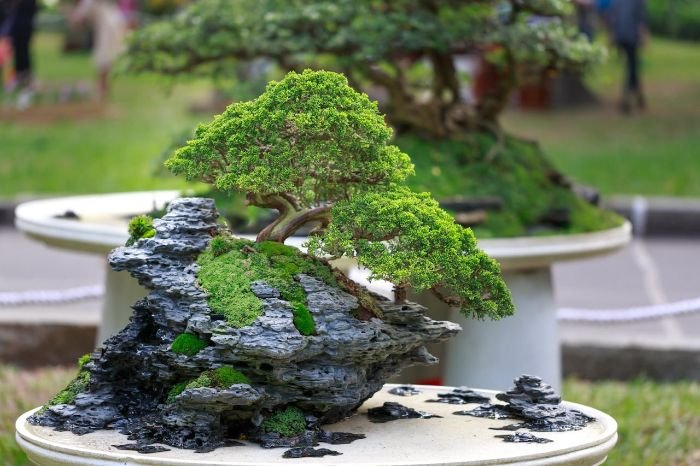
Choosing the Right Pot
Choosing a pot for your bonsai tree is important. The pot must be good for the tree’s roots and match its look. Think about size, material, and style when picking a pot.
The pot’s size should match the tree’s size. Big trees need deep, wide pots. Small trees do well in smaller pots. The pot should let the roots grow well.
The pot’s material affects its look. You can use ceramic, clay, or plastic. Ceramic and clay give a natural look. Plastic pots are light and strong. Pick a material that fits your bonsai’s style.
Style matters when choosing a pot. You can find round, rectangular, oval, or cascade pots. Each style suits different trees. The pot’s color and texture should match the tree’s leaves and trunk.
Display Stands and Accessories
Display stands and accessories are key to a great bonsai display. They make the tree stand out and add beauty.
There are many types of display stands. They lift the bonsai to eye level, making it a focal point. Wooden stands give a classic look. Metal stands are modern and sleek.
Use rocks, moss, and figurines to add depth and interest. These items make the bonsai look like a tiny landscape. They add texture and make the scene feel real.
Choosing the right pot, stand, and accessories is important. Think about different options and try them out. This way, you can make a bonsai display that wows everyone.
Inspiration and Further Learning
For those who love bonsai, this section is full of great info. It’s for both beginners and experts. It covers famous bonsai shows and books to help you learn more about bonsai.
Famous Bonsai Exhibitions
Bonsai exhibitions let artists show off their work and new skills. They bring together people from all over the world. It’s a chance to see the best bonsai art and learn from the pros.
The Sakufu-ten in Japan is a big deal every year. It shows many bonsai styles, old and new. The Artisans Cup in the U.S. also highlights the wide range of bonsai art.
Recommended Books and Resources
There’s a lot of info out there, but finding good Bonsai books and resources can be hard. We’ve picked out some top books and online stuff to help you:
- The Bonsai Workshop by Herb Gustafson – It’s a full guide from start to finish, from picking the right tree to advanced skills.
- Bonsai Today Magazine – A top magazine with articles, interviews, and tutorials from experts.
- Online Bonsai Communities – Join online groups to meet others and share ideas.
- Local Bonsai Clubs – Being in a local club connects you with pros who can help and support you.
These resources are great for any bonsai level. They offer new insights, skills, and inspiration for your bonsai hobby.
Conclusion
We’ve looked into the world of bonsai cultivation and care. Bonsai is more than a hobby; it’s an art that needs patience and skill. By using techniques like pruning and wiring, people can make tiny trees that look like the real ones.
Choosing the right bonsai tree is key. There are many species to pick from, each with its own traits. Beginners should start with trees that are easy to care for. This helps them get better before trying harder techniques.
Taking good care of bonsai trees is important. You need to water, fertilize, and give them the right soil and light. Following seasonal care tips and watching out for pests and diseases is also vital.
In the end, bonsai cultivation is a journey that mixes art with gardening. By following the advice in this guide, people can start a journey that brings beauty and nature into their lives. It’s great for both new and experienced bonsai lovers. The art of bonsai lets you create tiny masterpieces for life.
FAQ
What is bonsai?
Bonsai is an ancient Japanese art. It’s about growing and caring for tiny trees in pots.
How did bonsai originate?
It started in ancient China and grew in Japan.
What is the philosophy behind bonsai?
Bonsai shows how humans and nature can live in harmony.
What are the different styles of bonsai?
Bonsai comes in many styles. These include formal upright, informal upright, slanting, semi-cascade, cascade, literati, and windswept.
What tools are used in bonsai cultivation?
For bonsai, you need pruning shears, concave cutters, knob cutters, wire cutters, and bonsai scissors.
How do I choose the right bonsai tree?
Pick a bonsai tree based on its species, hardiness, growth habits, and how easy it is to care for.
What are the basic techniques used in bonsai?
Basic bonsai techniques include pruning, wiring for shape, and repotting with root trimming.
What are common problems faced by bonsai trees?
Bonsai trees often face pests, diseases, stunted growth, branch dieback, and root rot.






